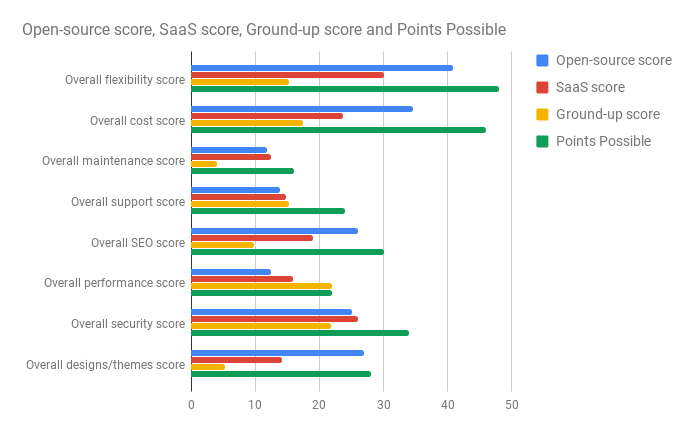Pros and Cons of Cart Ecommerce Types

In this article, we use our expertise as ecommerce developers specializing in SEO for online shopping carts to guide the reader by the most important consideration in deciding on a shopping cart platform, and one which most prospective etailers are unaware of, hence ignore: the cart type. To begin with, we ask a couple of very simple questions: Do you know whether you would consider leasing or buying a car before you go to a dealer? Would you know instantly whether you should, instead, pay to develop a custom car from scratch based on what you needed the car to do, like win a particular type of race? Why, then, would you not try to reach the same conclusion for your shopping cart?
Flexibility
First place: Open-source.
Of the 3 cart types, the open-source wins in terms of what it can do and what it can be modified to do compared to the others versus overall cost because it is not limited by who is employed by the party developing the software.
Pros:
- It has the largest pool of plugins/modules that make adaptations to the cart’s list of out-of-the-box features. With Open-source software, the term “There’s an app for that” is the most applicable.
- Updates to the software, especially the security, occur more quickly.
Cons:
- Developers must install and configure whichever plugins/adaptations you require for the cart to suit your needs.
- The updates still have to be performed by a development team.
Second place: SaaS.
The SaaS has only a very slight advantage on flexibility over the ground-up options due to the fact that changes to the cart are only developed once before it is made available to all of the active subscribers, so the subscribers share the cost of maintenance.
However, the flip side is the SaaS providers develop only those things that are demanded by the majority of their customers, while the number of 3rd party plugins is usually pretty low.
Pros:
- The cart is turned on as soon as you make your first monthly subscription payment, though no help in configuring the cart or entering products is provided, so you will still generally need someone experienced to work on it.
- The cost of developing and installing updates is shared by all subscribers.
- The availability of at least some plugins. Basically, “there might be an app for that.”
Cons:
- The cart functions and updates are limited to the budgeted time of their actively paid development team, so slower security updates and fewer rollouts of new features.
- Far fewer plugins available compared to Open-source.
- Generally, no access to make changes to the core code, or access is at least very limited.
- There is fair uncertainty that any one feature will remain in future updates or that plugins will be compatible in the future.
- We have seen a few cases where a particular use of an SaaS cart we have implemented for a customer has been lost in an update, so the cart no longer functions in the manner the business requires.
- Subscribers are generally stuck choosing between starting a new cart from scratch or paying the monthly subscription fee indefinitely.
Third place: Ground-up software.
Despite everything that is developed for the cart needing to be paid for by the customer directly, these are custom modifications to custom software. Meaning you only get what you need, and you only need what you get. You don’t have to worry about the code for a particular use of your cart software being removed in an update, and you don’t have to wait for a team of nameless software developers to decide to implement any changes you require.
Pros:
- The cart will only provide the functions you require in the manner you require, so you will get a massive boost in speed and efficiency compared to other cart types.
- Your cart will be less likely to suffer from code-bloat or slow-down with each modification you make.
Cons:
- Absolutely no plugins are available and anything new you require must be custom developed. In other words, “There is no app for that unless you’re willing to pay to develop one.”
Cost
First place: Open-source
Pros:
- Hosting costs: Open-source software doesn’t have a marked effect on the machine that it runs on other than to require a certain amount of resources to run.
- You also have the ability to negotiate since you can move your site to another host at any time.
- Lowest long-term cost compared to other cart types.
- The cost of developing security updates is free (for the open-source software and open-source plugins, but usually not for paid plugins).
- Many plugins are free.
- The only monthly cost is your hosting and maintenance, which is much cheaper than the monthly cost of SaaS or the maintenance of ground-up software.
Cons:
- Hosting costs: It often contains a lot of functions and database queries that a cart could otherwise do without, and for that reason alone it comes in second to Ground-up on hosting costs.
- You also have the ability to negotiate since you can move your site to another host at any time.
- Up-front development costs are higher than SaaS.
- Security updates and plugins still have to be incorporated into the cart by a paid developer.
- Some plugins and plugin updates are only available for a price.
Second place: SaaS.
Pros:
- Hosting costs: They’re usually included in the monthly subscription fee.
- Lowest up-front cost of entry compared to other cart types.
- The cost of security updates and general maintenance (not including simple product or content updates) is shared by all subscribers and automatically installed.
Cons:
- Hosting costs: even when they’re part of the monthly subscription fee, you’re still paying for it, and it’s still expensive compared to the other options.
- If you don’t like your host, you can’t move to a different one without abandoning your cart.
- Higher long-term costs compared to open-source.
- Very few plugins are free.
- Even though the cart is turned on as soon as you pay your first subscription fee, you will still need someone experienced to configure the cart for your business, and will generally receive almost no help from the SaaS provider.
- You cannot keep the cart without paying the monthly subscription fee, and once you stop paying and the cart is turned off, you basically have to start from scratch.
Third place: Ground-up software.
Pros:
- Hosting costs: The server can be as robust or as trim as it needs to be to suit your software, and you’re only paying for what you need.
- Can there be any cost pro when you pay more for less? As far as cost is concerned, there are no real pros, but here are a couple semi-pros:
- The first is one you only care about if you’re a developer: Frameworks have made ground-up software less expensive in recent years, but it is still expensive.
- I guess we can consider that when you pay for a ground-up solution, it is generally as awesome, efficient, and fast as it is expensive.
Cons:
- The first con of the cost of Ground-up software is you will pay for everything.
- And the second con of the cost of Ground-up software is you will pay for everything.
- Basically, nothing can be developed unless you pay to develop it and no changes can be made unless you pay for them to be made. That speaks volumes.
Maintenance
First place: SaaS
Developing and implementing bug fix updates is shared by all active subscribers. When an update removes functionality, however, you’ll still need the services of a developer to fix it (or move you to another cart if the change is drastic enough) so you’ll probably wind up paying a maintenance retainer anyway. There may be plugins that require an additional subscription to access plugin updates.
Second place: Open-source software
Developing updates for the core cart software doesn’t cost a thing, but you still need developers to implement them and will still need a maintenance retainer. There may also be plugins that require an additional subscription to access plugin updates.
Third place: Ground-up software
You have to pay for a developer to find every bug and develop the fix. Just like the other two cart types it requires a maintenance retainer. Unlike the other two, there is no shared cost. Conversely, when you or your visitors discover a bug, you can get your developers to work on it immediately.
Support
First place: Ground-up software
Whenever you have a problem, they are available, though it isn’t part of your monthly cost unless you have a maintenance agreement. Sometimes the software and updates carry a warranty, so within a certain amount of time support could be included. If you’re building your ground-up software in-house, then the cost is whatever you pay your developers plus the opportunity cost of whatever else they may have been able to work on. Prepare for a steep ramp up if you hire a new developer for support since they will need to get their bearings to understand the code.
Second place: SaaS
For the most part, SaaS software customer service reps only tell you how to use the cart and generally what you’re doing wrong, but they typically don’t fix problems specific to your cart. Again, you’ll probably need a maintenance agreement with a developer to fix the little things that go wrong. The number of developers with experience in a particular SaaS cart is fairly limited, but respectable.
Third place: Open-source
It is highly unlikely that you will ever receive any form of direct support from an Open-source development team. I mean… it’s free and entirely relies on the benevolence of the developer community. That said, Open-source software platforms usually have incomparable development communities who help people all of the time with troubleshooting and fixes on places like Stack-Exchange and the Open-source software’s own forums. Just don’t expect an immediate response from anyone other than the developers with whom you have a maintenance agreement. You will easily be able to find a developer that has experience working on nearly any particular open-source shopping cart.
Consideration: For any significant level of support or maintenance, you’re probably going to want to employ developers under a maintenance agreement no matter which cart type you use – That is, unless you already have in-house developers.
SEO
First place: Open-source software
Pros:
- Open-source tends to be more pervasive online, so it is more frequently encountered and better understood by search indexers.
- Again, a larger pool of developers means you generally have the best features. In this case, Open-source software tends to be contain better SEO features.
- Highly extensible, and can be adapted if you think you know better than the original software developers how to implement SEO on your website.
- SEO features tend to be the most accessible to laymen.
Cons:
- Being more accessible to laymen, changes can be made easily without fully understanding them. Misconfiguring the SEO features can have drastic consequences both short and long term, so Open-source still necessitates serious consideration of SEO services. You should consider a company specializing in ecommerce SEO.
Second place: SaaS
Pros:
- They definitely try to incorporate SEO features into their carts.
- A few internal SEO consultants and an update or two later, and the software is generally SEO friendly.
Cons:
- The software will still rely on the customer knowing and properly configuring their cart for SEO best practices, not to mention sound keyword research.
- Like Open-source, you’re probably still going to want the help of an SEO company specializing in ecommerce to configure the cart and optimize your products and categories.
Third-place: Ground-up software.
Pros:
- You get what you pay for. If you’re willing to pay for it, you’ll probably get something great.
Cons:
- You *ahem*… get what you pay for. If you don’t pay for it, you most likely will not get anything worthwhile.
- If your developers are just developers, and not specifically ecommerce SEO developers, they may create a cart for you that completely misses the key features of good SEO structure. So, again, you’re going to want to make sure either that your ground-up software developers specialize in SEO for ecommerce (and that you believe they know what they are doing), or you’ll want to procure the consultation services an SEO company specializing in ecommerce.
Performance
First place: Ground-up software
Bottom line, Ground-up software is configured and coded for performance and efficiency. It is the most expensive because you are paying for a highly-tuned, highly custom, highly fantastic piece of software. This is where Ground-up software blows the other two cart-types out of the water. You get only what you need, and need only what you get. Unfortunately, you also get only what you pay for, but that isn’t always a bad thing, right?
Second place: SaaS
SaaS makes attempts to add highly-demanded features, but you’re stuck with what they give you. In the case of performance, this is an advantage over Open-source because it means there is less to bog down the code and database.
Third place: Open-source
While SaaS does tend to try to implement all the features that Open-source has, much of the time the SaaS options are limited, as is the ability to adapt them. But this means that, as far as performance, Open-source tends to be limited to the ability of the developers who configure it and the server it is installed on due to having features and not needing them rather than needing features and not having them, which puts at a slight disadvantage… but only very slight.
Security
This is very nearly a 3-way tie since all of them really have major advantages and liabilities alike. Still, we did our best to rank them, but it isn’t without potential controversy.
First place: SaaS
Pros:
- There is usually a cost-of-entry to be a developer with access to the core code, so the core code is usually prohibitively expensive to look at for malicious parties.
- The security updates are rolled out automatically once developed.
- Is PCI-Compliant out-of-the-box, and with few abilities to fundamentally change the software, there is very little that can be done to break the compliance.
Cons:
- There are fewer developers finding and fixing security bugs.
Second place: Open-source
Pros:
- There are more developers discovering and patching security updates, so security updates take place much faster.
- There are more people using and contributing to the software, so security bugs are discovered much faster.
- Is PCI-Compliant out-of-the-box.
Cons:
- Vulnerabilities can be exposed more easily since Open-source code is available to everyone to look at. This is a bit of a doozy.
- Developers and store owners alike have far more freedom to make changes than with SaaS, so a small notch against Open-source PCI-Compliance is the capacity for human error.
Third place: Ground-up
Pros:
- The cart is custom, so knowing what to exploit is more difficult, which is a huge advantage as long as your developers utilize PCI-Compliance standards.
- Security updates are sometimes easier for the developers that designed the software in the first place. Therefore, it is not so expensive to implement security updates compared to the other cart types.
Cons:
- The work of writing security updates needs to be custom developed specifically for the cart by a developer so it is generally the slowest to be updated of the three cart types.
- Fewer developers looking for and discovering security bugs compared to open-source.
PCI-Compliance is only as good as the code written by the developers. Open-source and SaaS companies can tend to be comparatively better at this since Ground-up requires you have nearly exclusive access to a very good developer. The better the developer, the less available and more costly they become.
Designs/Themes
First place: Open-source software
Just like plugins being developed by their massive developer communities, Open-source software has the widest variety of designs and themes available, and each are also highly customizable themselves and cost very little. Additionally, changing the theme is fairly easy if you are unsatisfied with the results of the last theme you chose. Open-source wins this one without the need for debate.
Second place: SaaS
While not even coming close to the variety of themes/designs available to Open-source software, SaaS tends to have at least a few modules that are somewhat adaptable. In this sense, it may be a distant second, but it is also far ahead of ground-up.
Third place: Ground-up software
The only real advantage to themes in Ground-up software is that your site will look the way you want it and you’ll have total control over the appearance and functions if you’re willing to pay for them. However, design work of this type harkens back to 20 years ago when every design was custom and probably cost upwards of $50k. Another major drawback besides the cost is that, unlike Open-source and SaaS, if you don’t like the design, you’ll have to pay a lot more for any changes or for a completely new redesign. A lot of thought and work will have to go into designing the best interface possible to avoid doing it again, so don’t skimp!
Methodology
We took each of the pros and cons above and listed each as strengths in a spreadsheet. Then we weighted the strengths according to importance by drawing on our own experience and a general sense of the developer community as a whole. Finally, for each cart type, we assigned a score of 1-10 based on how positively they fulfilled each quality.
A condensed version of the results can be found in the chart below.

For a complete scoresheet, including the weights applied to each item scored, please feel free to download the Comparison of Cart Types spreadsheet
Results
We would expect to see that Ground-up is not the optimal solution in most cases, and that bears out with a score of 110.6 out of a possible 248 points. We would also expect to see Open-source and SaaS fairly close together since they tend to compete with one another. A score of 155.8 means that SaaS has 81% of the score that Open-source garnered, which is enough to put it on the table in anyone’s conversations.
Summary
It should come as no surprise that, with a total score of 191.4 out of a possible 248 points, Open-source is the cart type suitable for most businesses. It is lower cost, more robust, and more flexible all around. That fact that so many people use Open-source shopping carts already means fetching the top score is not an anomaly, it is a verification. Stores that have begun on SaaS may find some benefit in moving to Open-source if their needs aren’t quite being met.
SaaS falls in at second due to its fast startup ability, lower up-front costs, and generally worry-free maintenance. Many etailers just starting out will tend to opt for SaaS for the above reasons. Its overall score of 155.8 out of 248 puts it into most considerations for small and medium sized business alongside Open-source options.
Ground-up may fall into last place, but that is because it is a very special type of business that requires ground-up development to exactly meet their needs, while having greater budget flexibility over small and medium-sized businesses. Fetching less than half of the possible points shows it is not the best solution for most businesses. Last but not least, ground-up software does not need to compete with Open-source or SaaS because it is doing fine on its own terms.
[do_widget id=grp_widget-2]






